Explore our IP Address Database Downloads for instant access to our IP address insights
Learn moreHow brick-and-mortar can use geolocation tech to compete with the giants
Once upon a time, brick-and-mortar had very little competition. A boutique shop would be competing with just 2 or 3 other shops in the areas, a health food shop might be the only one in a given neighborhood, and the local dive bar was guaranteed the after-work crowd within a 5 block radius.
Today, that competition has multiplied a thousand-fold. You’re competing with:
- A bigger area of shops, that people now travel further to in order to get what they want
- E-commerce, that people can now get the same shoes on for a fraction of the cost online
These factors pose extinction for brick-and-mortar — especially paired with the high overhead operating costs of a physical business and the relatively low marketing budget.
But there are some brick and mortars that seem immune to this digital evolution. They’re getting butts-in-seats, and shoes on pavement in their locations and are continuing to grow.
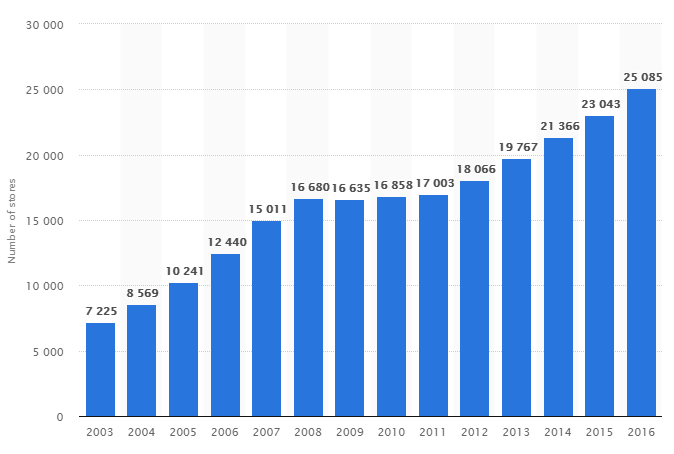
How come?
Breaking The Convenience Wall
E-commerce businesses work with focus groups, send out surveys, and even get on the phone with individual customers to get enough data to provide a good customer experience. But even the best attempts fall flat. You simply can’t have the same sort of personal experience with a computer screen as you can with a person.
The same tech that creates convenience also creates distance between the brand and the consumer.
Successful brick-and-mortar stores leverage what they do have: a personal, human experience where you can look closely at, touch, smell, and try things on for size. They also add a layer of convenience that digital retailers offer — they connect and provide value to their customers when they’re outside the storefront.
Using geolocation technology, brick-and-mortar shops extend that personal in-store experience to new and repeat customers alike. They use geographic proximity as a way to target new customers and re-engage existing customers, and they pair that with the massive distribution possible through the internet.
There are three types of technology you can use to achieve this:
- Geotargeting, which is achieved by sending customized messages based on location. So your New York customers would see different messages and design from your customers in Boston. Geotargeting can be done via a third-party platform, such as Facebook, Twitter, Snapchat, or Google Ads or by customizing your landing page for location-specific messaging.
- Geofencing, which is achieved by creating a virtual fence around the location of your store and reaching out to everyone within that specified vicinity. So everyone within 50 miles of radius of a specific location would receive a mobile message. This is done primarily through push or SMS notifications.
- Beaconing, which is achieved by sending messages to people within or right outside your store. This is done via an app that has Bluetooth enabled.
Geolocation tech lets you connect with interested locals on social media, on your website, and on mobile — but in a way that bridges the digital experience with the in-store experience. So whether they’re out of town, walking by the store, or navigating your aisles, you have the opportunity to engage them.
Here’s how to take advantage of each type of location technology and the toolset to do so.
Geotarget to Find New Customers
Geotargeting is the most popular form of location-based marketing because it gives you the farthest reach. You can reach customers who have no experience with your brand and nudge them to come visit your store or business if they’re in the area. If you have several locations, you can have location-specific advertisements that are catered to that particular segment of your customers.
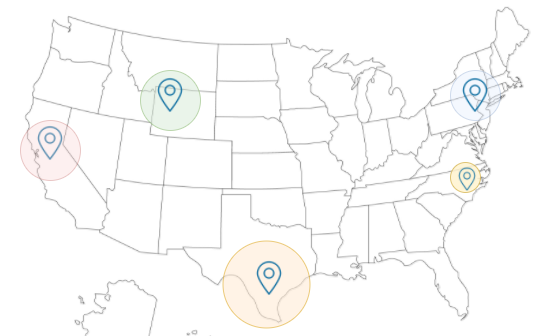
Warby Parker, for instance, sends this social ad to potential customers in the Bay Area:
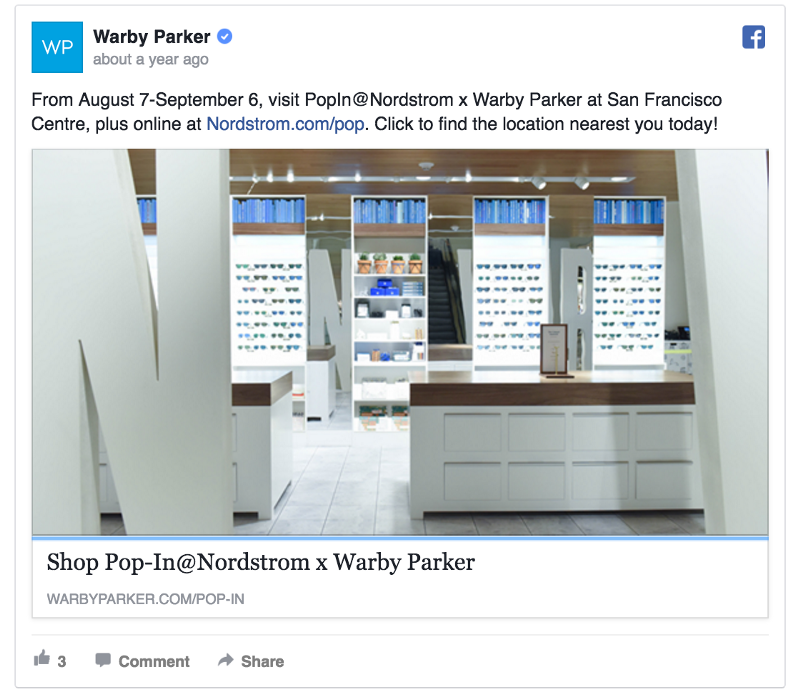
Their promotion would snag the attention of more than Nordstrom’s foot traffic — it’ll snag the attention of anyone living in the area who’s on Facebook, or even someone passing through town who’s looking through their feed on their phone. Warby Parker pairs the location details with Facebook behaviors, so you’d only see this ad if you’ve been browsing for a new pair of shades in the first place.
The same tech can be used for the people once they click through to your website. Tesla shows new customers all their nearby stores and service centers, based on the location of the web visitor.

You can’t test-drive a car online, but you can see the convenience of owning that car on a map. Tesla dispels reservations about buying a fully-electric car by showcasing the charging stations on a map.
E-commerce’s big advantage over brick-and-mortar is their access to a larger audience — they’re able to get more eyeballs on their brand. By using the same channels but tying them to the in-store experience via geolocation tech, you can have more touch points with potential customers. This lets you combine the personal, in-store experience with the marketing reach available to online vendors.
Geotargeting Tools
Geotargeting is possible because geolocation companies take it upon themselves to use tech such as pings, traceroutes, and reverse DNS to match IP addresses with locations. Various plug-ins and marketing tools use this data to let you take advantage of location-tech without having to actually know the nitty-gritty details.
Here are a few different channels you can use to customize marketing for your brick-and-mortar store:
- Social media such as Facebook, Instagram, and Twitter give you a lot of options when it comes to targeting highly-specific audiences, and location is one of them. You can target based on proximity to your store, based on location, and based on location and behavior. So if you have a school supply shop in Midtown New York, you can send out ads to people who have engaged with school-related Facebook pages and who live in Manhattan.
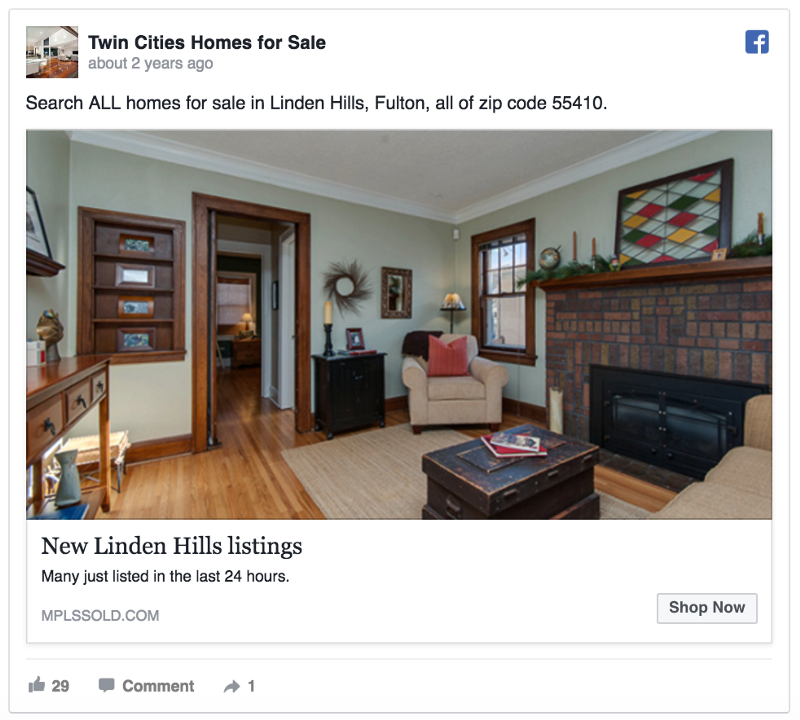
- Paid search ads, available on search platforms like Google and Yahoo. They typically let you target entire countries, cities or territories or a square mile radius around a particular location. A study recently proved a link between paid ads and brick-and-mortar profits: consumers who clicked on a Google Ad are 25% more likely to buy when in the store, and will spend 10% more.

- IPinfo lets you customize your website, based on a user’s location. Your website designer only needs to insert a few snippets of code to have location-specific design and copy show up for your site visitors.
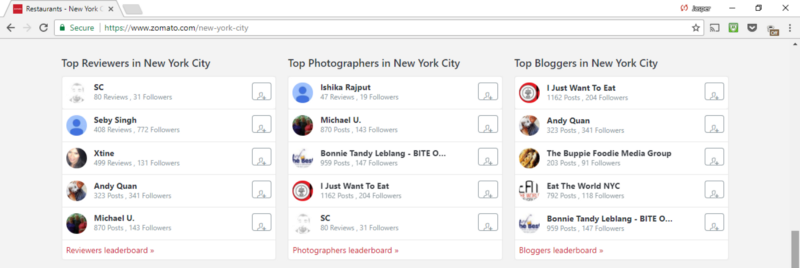
Using geotargeting tools, your entire relationship with a new customer can start as highly personal — from the first touch (via a social ad), to engagement on your customized website, to the moment they walk through your door.
Geofence to Get Repeat Customers
Geofencing is a tool you can use to turn one-time customers into frequent store visitors. This form of location-based tech utilizes SMS and push notifications, so you need permission from the customer before you can reach out. If you create a strategy for securing that permission, however, you’ll have more ways to connect with interested people when they’re just a walk, a subway, or a car-ride away.
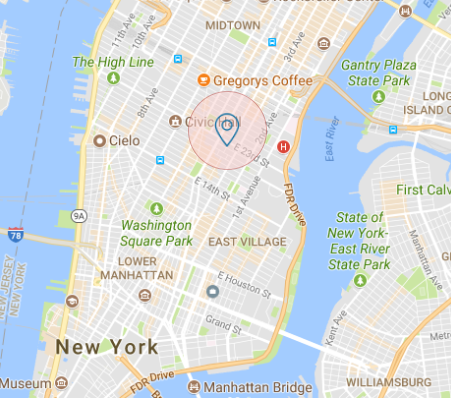
Installing your app has to be a mutually-beneficial activity. Your app can’t just deliver the same information that’s available in your store — it needs to offer extra incentives, such as a rewards program or some kind of VIP treatment. You can cross-promote this app both in-store and via digital channels.
When it comes to actual content, leverage the proximity of your target audience to your advantage. Time-sensitive promotions and reminders of local events trigger loss aversion in customers, inciting them to make the small effort of visiting the location asap.
Make-up retailer, Sephora, keeps track of gift cards in their app, so that any time a customer passes by a location, they nudge them to stop by and make a purchase:
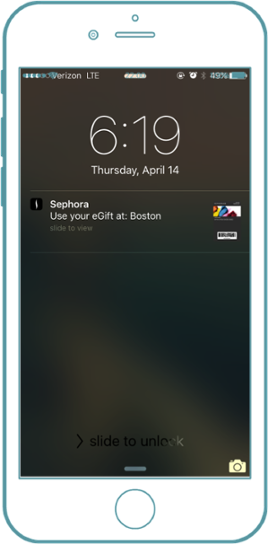
This positively re-inforces a customers’ interaction with the brand, since they’re being prompted to get stuff that’s already paid for. Customers are happy with more stuff, and Sephora gets more people through their doorway.
Starbucks takes it a step further and makes the app a part of a long-term relationship between the coffee shop and its loyal patrons. It uses both geolocation data paired with details on previous purchases to inform their notifications. They remind users of discounts on the specific items that they frequently purchase:
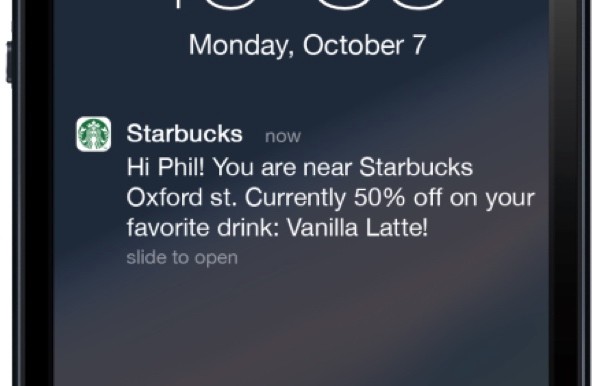
Starbucks takes past behavior and makes it easier to act on it again. These types of nudges help create habits that turn infrequent customers into brand advocates who can’t live without their morning Vanilla Latte.
The stats show that the most technically-engaged generation — millennials — are the most brand loyal. This is because there is more opportunity to engage with brands than ever before, since consumers can interact with businesses on the same platforms where they interact with their friends, family, and co-workers. Geofencing is another way of bringing your business into the daily lives of your customers.
Geofencing tools
In order to set up Geofencing, your business needs to have a mobile app. If it doesn’t, many basic app-builders — that don’t require technical chops — have geofencing capabilities built-in, such as Bizness apps.
If you already have a mobile app, the easiest way to set up Geofencing is through an SDK — a developer toolkit that lets your app dev team integrate this feature in just a few hours. There are a few different services that offer these:
- Onradar is the most lightweight integration that we’ve found. It lets you gather simple data such as where a user lives and what geolocations they frequent. You can also set up formulas for sending notifications such as: send “welcome home!” when a customer has visited the airport and the local neighborhood. Onradar has a free plan that lets you use the product for up to 100,000 monthly tracked users (MTUs).
- PlotProjects is a full-package deal. You can integrate geofencing capabilities to send push notifications at specified times and locations, but you also get an entire analytics dashboard where you can learn about where your customers spend their time. PlotProjects lets you build buyer personas around locations and past purchasing behaviors.
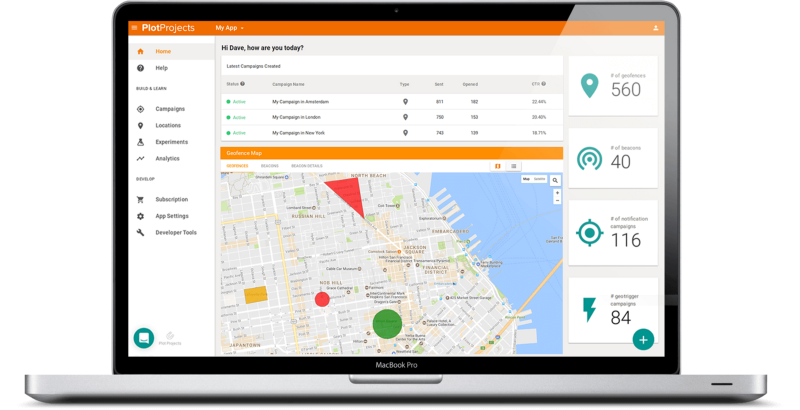
As you start using Geofencing more, you’ll be able to pair location data with qualitative data you get in-store. If you ask customers what brought them in that day, or which of their expectations weren’t met during their in-store experience, you’ll fill in the blanks about why they’re spending time at a competitor’s shop, or why the time they spend in the neighborhood has decreased. This will help you build more-robust profiles for better targeting in the future.
Beacon to Engage Existing Customers
Beaconing is the location technology that has the shortest, but most accurate range. It’s used to engage with and learn about customers who are already inside your store. Beaconing can make the in-store experience more efficient, more informative, and more rewarding.
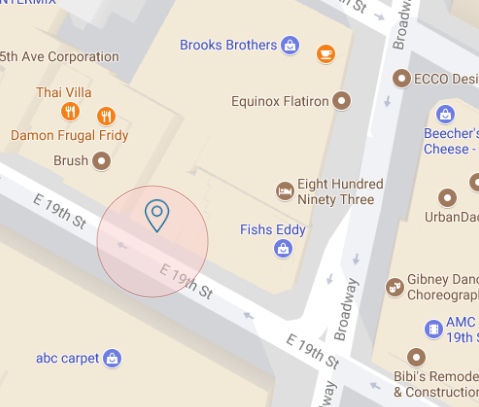
Americans spend up to 5 hours each day on their phones — within and outside of your store. To get full engagement, grab their attention where they’re already spending it.
Target uses beaconing to send aisle-specific discounts and promotions as the customer walks by the relevant items.
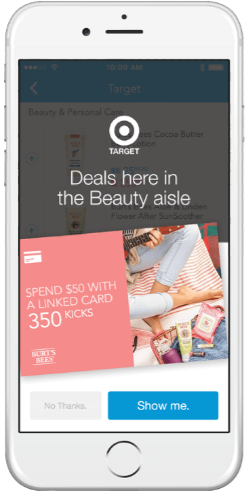
Coupons that are sent to shoppers as they’re browsing an aisle can offer that little extra incentive to throw the item in the cart. If you have a long-term rewards program, it’ll help shoppers create the habit of checking the app and look for ways to engage with your store consistently.
Australian grocery store, Woolworths, uses beacon technology to expedite the grocery shopping experience:
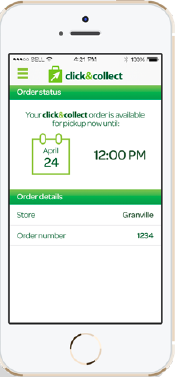
Shoppers can pick out their items ahead of time via the app, and as soon as they step foot in the store, an employee starts collecting and bagging the items for them. They can go directly to the pickup counter, or snag a couple of extra items on the way. This cut shoppers’ time in half, giving them a much more positive experience during their weekly grocery run.
Ikea uses beaconing technology to help customers navigate through the 3-story labyrinth of furniture and home goods:

Ikea’s greatest quality: useful furniture for a great price that you can feel good about because you built it yourself. Their worst? The endless, snakelike aisles make even a quick shopping trip an hour-and-a-half affair. Ikea recently released an app that mitigates this issue by pointing users to exactly where they need to go with their app.
Beaconing tech lets you augment your shopping experience. Any issue that you have in the store — whether it’s cost, convenience, or navigability — you have the opportunity to address it with a mobile app.
Beaconing tools
A beacon is a relatively inexpensive piece of hardware that links up with your phone via Bluetooth. This triggers your phone to open up an app (either yours or a third party's), and from there you can engage with your customer, giving them information that’s relevant to them based on where they are in your store.
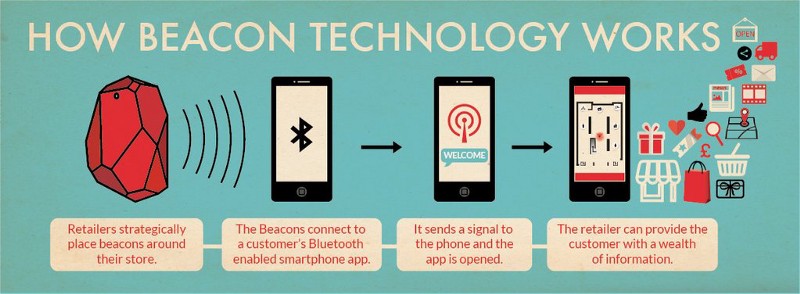
If you want to set up beaconing tech in your store, you have two options:
- Create a page through a beacon app. Services like Live Beacon will host your app, send you the hardware, and enable you to send any kind of custom messages to your customers based on their location. Customers have to be willing to install the Live Beacon app, unless they have the latest Androids which automatically come with Live Beacon software.

- Partner with a third-party service. You can use a rewards app service like Shopkick, who currently work with SMBs and huge retail chains like Crate and Barrel and Macy’s. They set you up with a beacon, and give your store a page and reward program in their app, for a small fee. Your customers have an extra incentive to download the app since it can get them discounts for several of the stores that they shop at.
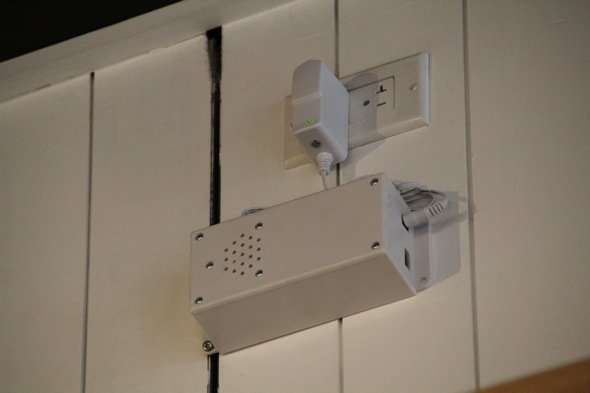
Beaconing is the extra personal touch on the in-store experience that makes it incomparable to digital. You can let customers keep everything they like about in-person shopping — the touch-and-feel, the ability to browse displays and shelves, the ability to try things on — and eliminate the things they hate — the long lines, the wasted time, and the high prices.
Expand Engagement Past Your Bricks
Headlines that have been promising the demise of brick-and-mortar the past ten years have been missing the point. The brands that will survive aren’t the ones that choose how to connect with consumers — it’s the ones that connect with consumers in the way that they chose.
Shoppers like going to stores — but they also like engaging with stores on social, at home, and via mobile. Utilizing location-based technology is the best way to bridge the digital and physical shopping experience to create and experience that differentiates you from other brick-and-mortar shops and e-commerce platforms.
IPinfo is a comprehensive IP data and API provider with flexible pricing plans to meet your business needs. We handle billions of API requests per month, serving data like IP geolocation, IP to company, and more. Sign up for a free account or contact our data experts to learn more.
About the author

Internet Data Expert